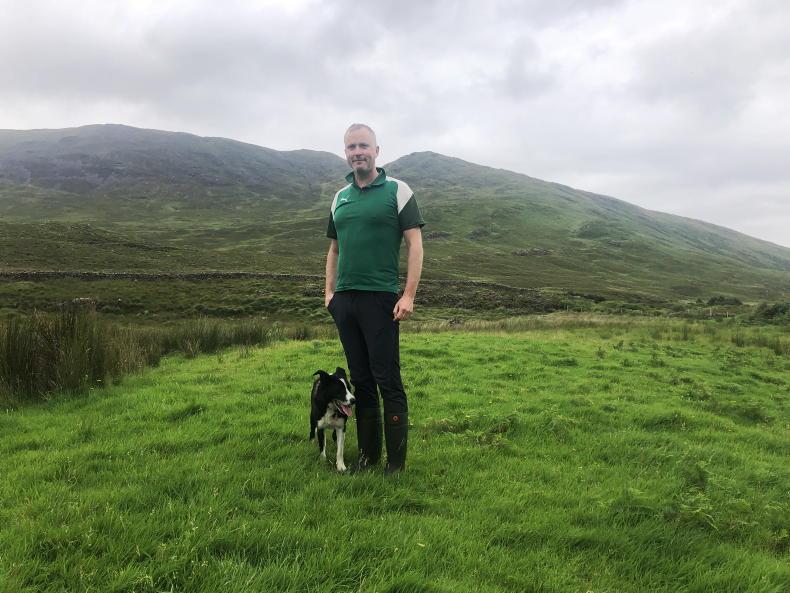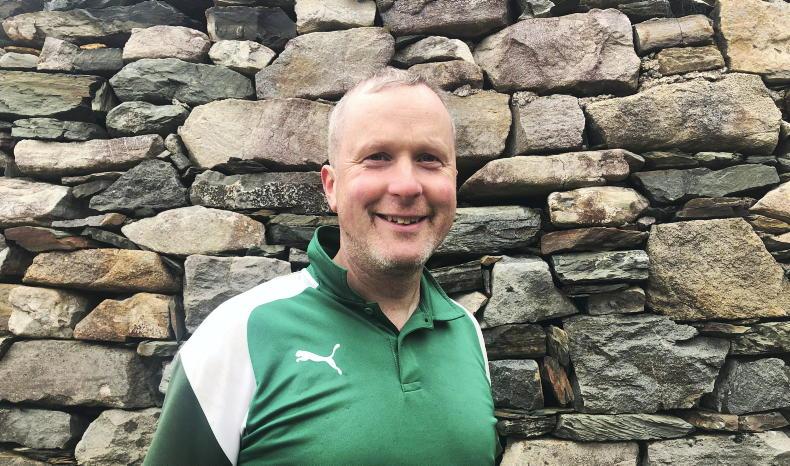Colm Gavin is a full-time hill sheep farmer with 120 Mayo black-faced breeding ewes kept on his scenic 110ha Connemara holding. Indeed, if you could sell scenery – spectacular mountain ranges plunging into deep fjords, dissected by rushing rivers and flanked by contour-hugging roads – Colm would be a rich man. But wealth comes in many forms, and it’s clear that Colm’s comes from his love of the farming life and from eight generations of family rootedness in this very special community and place.
On arriving at the home of Colm and his wife Eimear, Colm shows me a docket he just got for his wool. The 5 cent a kilo received is a lot less that the €3 it cost to actually shear a sheep, or the €13 price of a 50g hank of single-dyed wool sold at a nearby store.
Though Colm operates a very low-cost system to produce his lambs – usually sold direct in August, as stores, to a midlands buyer – farming here is clearly not a very lucrative business. But for Colm, it’s much, much more than that: a way of life, a culture, a heritage, an identity.

Colm Gavin (with his dog Coolie) is an eighth-generation, full-time hill sheep farmer with 120 Mayo black-faced breeding ewes kept on his 110ha Connemara holding.
Nonetheless, to survive here as a full-time farmer, bills have to be paid and what’s notable in this regard about Colm’s farming journey is how he has harnessed his knowledge and stewardship of the celebrated Connemara landscape to supplement his farm income.
Blending science with local
knowledge
While Colm has participated in AEOS, GLAS and, most recently, ACRES, it was the EIP-funded ‘Pearl Mussel Project’ (PMP) that really engaged him. The bespoke local approach, practical ideas, incentive-based payments and freedom to farm made sense to him, and he felt listened-to, respected and valued as a farmer. A modest and pragmatic man, he describes simple solutions like building silt traps at drain heads so that sediment wouldn’t enter the river, hugely effective in sustaining water quality; but he equally recalls occasions when he let the project team know that some of their ‘half-cracked’ ideas simply wouldn’t work. This blend of solid science and practical knowledge helped ensure that the Bundorragha catchment, where Colm farms, continues to host the healthiest population of these rare freshwater pearl mussels in Europe.
The PMP engagement was so positive that Colm subsequently signed up for the EU LIFE IP funded ‘Wild Atlantic Nature’ (WAN) project. Through WAN and its partners, Colm received training and equipment to tackle the ongoing encroachment of rhododendron in the area.
Today Colm and seven other chainsaw-wielding locals have become unlikely ‘first responders’ to this local environmental challenge – leveraging significant economic and social benefits in doing so. Colm is enthusiastic about the potential for this farmer-led model of conservation to expand to other regions and to include other works such as repairing walls and stabilising riverbanks through tree planting.
Earning from the environment
Colm recognises the growing ‘value’ of the environment to his farm business, but also the need to work with other partners to make it pay. Projects like PMP and WAN have given him the confidence, skills and support to earn a locally-based income, spend valuable time with his neighbours, while also allowing him time to farm his land.

What’s notable about Colm’s farming journey is how he has unlocked new opportunities through his knowledge and stewardship of the celebrated Connemara landscape.
This approach is, for Colm, far more constructive than the polarising – and ‘very frustrating’ – debate on social media around farming and the environment, and helps allay his fears of an abandoned landscape, instead offering hope for a brighter farming future.
While Colm’s farming journey isn’t unique, what sets him apart is his open-mindedness. Like his father Martin, a widely respected community leader and IFA member, Colm engages a lot with other people – farmers, researchers, public bodies – hosting countless study groups on his farm.
This has been a great way to understand other perspectives and to further supplement his income, as his experience as a farmer is increasingly valued – and paid for – by such groups.
It’s refreshing to meet Colm and to be reminded of how much farmers can contribute to the richness, understanding and care of this stunning landscape.
Colm’s farming journey, and his commitment to his community and place, should offer inspiration to ‘High Nature Value’ (HNV) farmers elsewhere.
Let’s hope that a new generation of Agri-Environment schemes like EIPs, ACRES and others can enable this necessary reimagining of HNV farming as an industry that can sustain thriving communities, flourishing landscapes and open-minded farm families like the Gavins.
Colm Gavin is a full-time hill sheep farmer with 120 Mayo black-faced breeding ewes kept on his scenic 110ha Connemara holding. Indeed, if you could sell scenery – spectacular mountain ranges plunging into deep fjords, dissected by rushing rivers and flanked by contour-hugging roads – Colm would be a rich man. But wealth comes in many forms, and it’s clear that Colm’s comes from his love of the farming life and from eight generations of family rootedness in this very special community and place.
On arriving at the home of Colm and his wife Eimear, Colm shows me a docket he just got for his wool. The 5 cent a kilo received is a lot less that the €3 it cost to actually shear a sheep, or the €13 price of a 50g hank of single-dyed wool sold at a nearby store.
Though Colm operates a very low-cost system to produce his lambs – usually sold direct in August, as stores, to a midlands buyer – farming here is clearly not a very lucrative business. But for Colm, it’s much, much more than that: a way of life, a culture, a heritage, an identity.

Colm Gavin (with his dog Coolie) is an eighth-generation, full-time hill sheep farmer with 120 Mayo black-faced breeding ewes kept on his 110ha Connemara holding.
Nonetheless, to survive here as a full-time farmer, bills have to be paid and what’s notable in this regard about Colm’s farming journey is how he has harnessed his knowledge and stewardship of the celebrated Connemara landscape to supplement his farm income.
Blending science with local
knowledge
While Colm has participated in AEOS, GLAS and, most recently, ACRES, it was the EIP-funded ‘Pearl Mussel Project’ (PMP) that really engaged him. The bespoke local approach, practical ideas, incentive-based payments and freedom to farm made sense to him, and he felt listened-to, respected and valued as a farmer. A modest and pragmatic man, he describes simple solutions like building silt traps at drain heads so that sediment wouldn’t enter the river, hugely effective in sustaining water quality; but he equally recalls occasions when he let the project team know that some of their ‘half-cracked’ ideas simply wouldn’t work. This blend of solid science and practical knowledge helped ensure that the Bundorragha catchment, where Colm farms, continues to host the healthiest population of these rare freshwater pearl mussels in Europe.
The PMP engagement was so positive that Colm subsequently signed up for the EU LIFE IP funded ‘Wild Atlantic Nature’ (WAN) project. Through WAN and its partners, Colm received training and equipment to tackle the ongoing encroachment of rhododendron in the area.
Today Colm and seven other chainsaw-wielding locals have become unlikely ‘first responders’ to this local environmental challenge – leveraging significant economic and social benefits in doing so. Colm is enthusiastic about the potential for this farmer-led model of conservation to expand to other regions and to include other works such as repairing walls and stabilising riverbanks through tree planting.
Earning from the environment
Colm recognises the growing ‘value’ of the environment to his farm business, but also the need to work with other partners to make it pay. Projects like PMP and WAN have given him the confidence, skills and support to earn a locally-based income, spend valuable time with his neighbours, while also allowing him time to farm his land.

What’s notable about Colm’s farming journey is how he has unlocked new opportunities through his knowledge and stewardship of the celebrated Connemara landscape.
This approach is, for Colm, far more constructive than the polarising – and ‘very frustrating’ – debate on social media around farming and the environment, and helps allay his fears of an abandoned landscape, instead offering hope for a brighter farming future.
While Colm’s farming journey isn’t unique, what sets him apart is his open-mindedness. Like his father Martin, a widely respected community leader and IFA member, Colm engages a lot with other people – farmers, researchers, public bodies – hosting countless study groups on his farm.
This has been a great way to understand other perspectives and to further supplement his income, as his experience as a farmer is increasingly valued – and paid for – by such groups.
It’s refreshing to meet Colm and to be reminded of how much farmers can contribute to the richness, understanding and care of this stunning landscape.
Colm’s farming journey, and his commitment to his community and place, should offer inspiration to ‘High Nature Value’ (HNV) farmers elsewhere.
Let’s hope that a new generation of Agri-Environment schemes like EIPs, ACRES and others can enable this necessary reimagining of HNV farming as an industry that can sustain thriving communities, flourishing landscapes and open-minded farm families like the Gavins.








 This is a subscriber-only article
This is a subscriber-only article












SHARING OPTIONS: